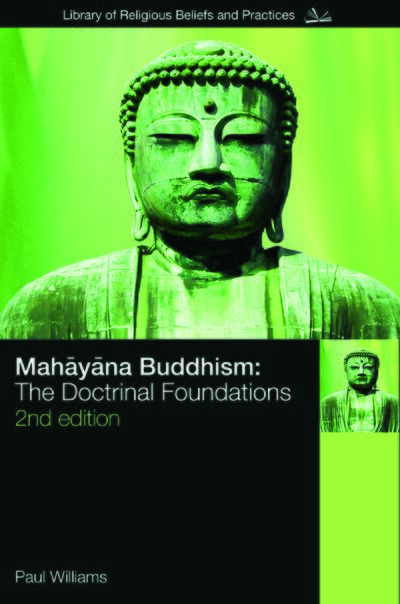Mahāyāna Buddhism: The Doctrinal Foundations
< Books
| Line 57: | Line 57: | ||
**{{i|''Nichiren Shōnin and his tradition''|165}} | **{{i|''Nichiren Shōnin and his tradition''|165}} | ||
*{{i|'''8 On the bodies of the Buddha'''|'''172'''}} | *{{i|'''8 On the bodies of the Buddha'''|'''172'''}} | ||
| − | Prolegomenon to the | + | **{{i|''Prolegomenon to the Mahāyāna''|172}} |
| − | The bodies of the Buddha and the philosophy of emptiness 176 | + | **{{i|''The bodies of the Buddha and the philosophy of emptiness''|176}} |
| − | + | **{{i|''Yogācāra – the system develops''|179}} | |
| − | A note on the dGe lugs schema of the | + | **{{i|''A note on the dGe lugs schema of the Buddha's bodies''|182}} |
| − | A final note: the | + | **{{i|''A final note: the 'nonabiding nirvāṇa' and the lifespan of the Buddha''|185}} |
| − | + | *{{i|'''9 The path of the Bodhisattva'''|187}} | |
| − | 9 The path of the Bodhisattva 187 | + | **{{i|''Buddhism reaches Tibet''|187}} |
| − | Buddhism reaches Tibet 187 | + | **{{i|''The eighth-century debates''|191}} |
| − | The eighth-century debates 191 | + | **{{i|''Compassion and the Bodhicitta''|194}} |
| − | Compassion and the Bodhicitta 194 | + | **{{i|''Bodhisattva stages, paths and perfections''|200}} |
| − | Bodhisattva stages, paths and perfections 200 | + | *{{i|'''10 Trust, self-abandonment and devotion: the cults of Buddhas and Bodhisattvas'''|'''209'''}} |
| − | 10 Trust, self-abandonment and devotion: the cults of Buddhas and Bodhisattvas 209 | + | **{{i|Buddhānusmṛti – ''recollection of the Buddha''|209}} |
| − | + | **{{i|''The'' pratyutpanna samādhi ''and Huiyuan''|212}} | |
| − | The pratyutpanna | + | **{{i|''The notion of a Buddha Field'' (buddhakṣetra)|214}} |
| − | The notion of a Buddha Field ( | + | **{{i|''Some Bodhisattvas''|218}} |
| − | Some Bodhisattvas 218 | + | ***{{i|''Maitreya''|218}} |
| − | Maitreya 218 | + | ***{{i|''Avalokiteśvara''|221}} |
| − | + | ***{{i|''Tārā''|225}} | |
| − | + | ***{{i|''Mañjuśrī''|226}} | |
| − | + | ***{{i|''Kṣitigarbha''|229}} | |
| − | + | **{{i|Some Buddhas|231}} | |
| − | Some Buddhas 231 | ||
AkWobhya 231 | AkWobhya 231 | ||
BhaiWajyaguru 234 | BhaiWajyaguru 234 | ||
Revision as of 14:21, 26 June 2020
Originating in India, Mahayana Buddhism spread across Asia, becoming the prevalent form of Buddhism in Tibet and East Asia. Over the last twenty-five years Western interest in Mahayana has increased considerably, reflected both in the quantity of scholarly material produced and in the attraction of Westerners towards Tibetan Buddhism and Zen.
Paul Williams’ Mahayana Buddhism is widely regarded as the standard introduction to the field, used internationally for teaching and research and has been translated into several European and Asian languages. This new edition has been fully revised throughout in the light of the wealth of new studies and focuses on the religion’s diversity and richness. It includes much more material on China and Japan, with appropriate reference to Nepal, and for students who wish to carry their study further there is a much-expanded bibliography and extensive footnotes and cross-referencing. Everyone studying this important tradition will find Williams’ book the ideal companion to their studies. (Source: Routledge)
| Citation | Williams, Paul. Mahayana Buddhism: The Doctrinal Foundations. 2nd ed. The Library of Religious Beliefs and Practices. New York: Routledge, 2009. https://archive.org/details/mahayanabuddhismthedoctrinalfoundationspaulwilliamsroutledgeseealtruismandreality_202003_445_W/mode/2up. |
|---|---|

